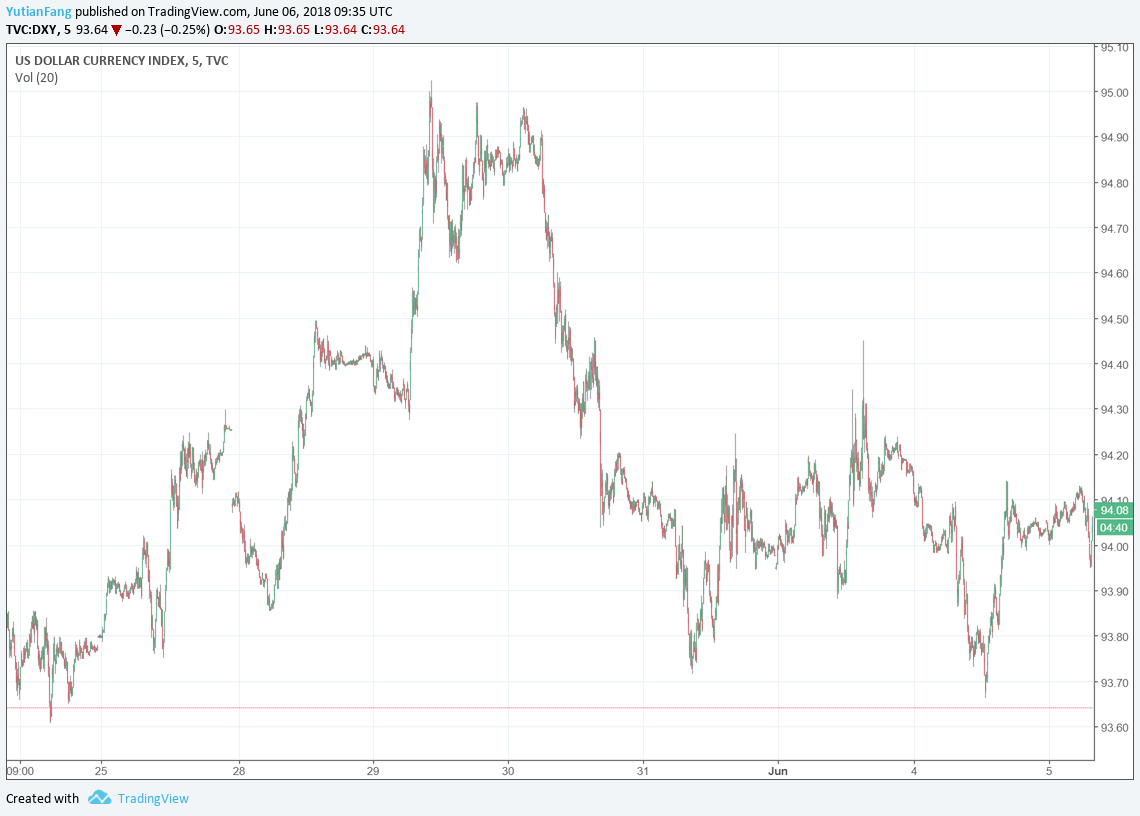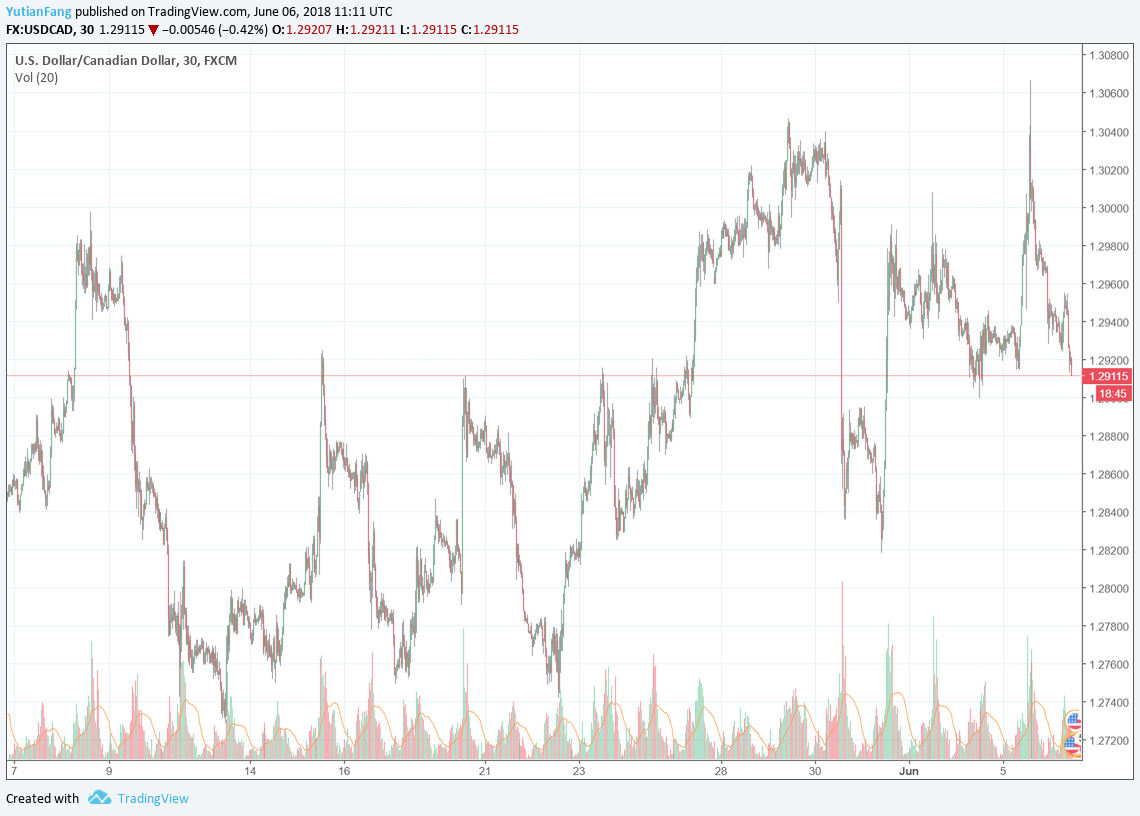Currency Review: Event-Heavy Week for US Dollar
The US dollar surged early last week as the uncertainty on Euro arose due to political events happened in Europe and the volatility to Asian markets increases driven by immediate trade war between the US and China. On Thursday, the Euro rebound as Italy’s politicians seemed to have found a resolution to the post-election. In the same day, Trump administration announced it was putting tariffs on steel and aluminum imports from Canada, Mexico and Europe, strengthening fears over the trade war and making US dollar suffer a slump.
 DXY Index Price Chart: 5-minute Timeframe (from May 25 to June 5, 2018). Source: Tradeview.com
DXY Index Price Chart: 5-minute Timeframe (from May 25 to June 5, 2018). Source: Tradeview.com
The US labor indicators highlighted the fundamental strength of the country’s economy and made US dollar extend gains amid the Europe geopolitical turmoil. As the US job report for May released last Friday, 223,000 new jobs were created last month with the unemployment rate dropping to its 18-year low of 3.8%. Besides, American workers’ average hourly wage rose by 0.3% to $26.92 and the yearly rate of pay increased by 2.7%, which makes market’s expectation for inflation higher. The U.S. Dollar Index (USDX, DXY, DX), which measures the value of the United States dollar relative to a basket of foreign currencies, increased by 0.2% at 94.213 after the job data published. The market becomes convinced that the economy is on the growing above trend and is expecting that Federal Reserve is more aggressive on raising interest rate in June.
 A steel production site in Ontario. Source: The Canadian Press
A steel production site in Ontario. Source: The Canadian Press
 USD/CAD Price Chart: 5-minute Timeframe (from May 25 to June 5, 2018). Source: Tradeview.com
USD/CAD Price Chart: 5-minute Timeframe (from May 25 to June 5, 2018). Source: Tradeview.com
Canada dollars soured as Bank of Canada left the Canadian interest rates unchanged on May 30th and issued a positive statement implying a faster pace to increase rate later. The USD/CAD closed at 1.2963 on Thursday by an increase of 69 bps after President Trump announced tariffs on steel and aluminum imports from Canada, Mexico and European countries. Canadian Prime Minister Justin Trudeau was introducing dollar for dollar tariffs on imports from US, products ranging from steel to whisky. Canadian dollar suffered a further slide as oil prices slumped for the fourth consecutive day on June 5th.
 USD/JPY Price Chart: 5-minute Timeframe (from May 25 to June 5, 2018). Source: Tradeview.com
USD/JPY Price Chart: 5-minute Timeframe (from May 25 to June 5, 2018). Source: Tradeview.com
Because of its safe haven status, Japanese Yen strengthened as political risks in Euro zone were rising last week. However, it started weakening since US payrolls data disclosed. Japan’s household spending data released with an annual decline of 1.3% indicated that private assumption fell and export demand became more soft than expected, making the economy prospect seen gloomier. The Japanese central bank is struggling to achieve the target inflation rate of 2% and economists overall believe that the economy would likely recover in the second quarter. We will see Q1 GDP growth and currency account for April at the end of this week. Currently, the USD/JPY upward trend looks steady and the price is targeting a breakout of 110.000.
On May 25, I Know First Algorithm gave USD/CAD a bullish signal of 1.09 with the predictability of 0.24, suggesting we have quite confidence in the increase of USD/CAD. In accordance with the prediction, USD/CAD increased by 0.50% in the forecasting period. Our algorithm also successfully predicted EUR/USD movement by observing a signal of -2.64 and a predictability of 0.16. In 7 days after the forecast updated, EUR/USD decreased by -0.5%.

How to interpret this diagram:
Algorithmic Currency Forecast
The table on the left is a currency forecast produced by I Know First’s algorithm. Each day, subscribers receive forecasts for six different time horizons. Note that the top currencies in the 1-month forecast may be different than those in the 1-year forecast. In the included table, only the relevant tickers have been included. The boxes are arranged according to their respective signal and predictability values (see below for detailed definitions). A green box represents a positive forecast, suggesting a long position, while a red represents a negative forecast, suggesting a short position.
Signal
This indicator represents the predicted movement/trend of the asset; not a percentage or specific target price. The signal strength indicates how much the current price deviates from what the system considers an equilibrium or “fair” price.
The sign of the signal tells in which direction the asset price is expected to go (positive = to go up = Long, negative = to drop = Short position), the signal strength is related to the magnitude of the expected return and is used for ranking purposes of the investment opportunities.
Predictability (P)
This value is obtained by calculating the average correlation coefficient between the past predictions and the actual asset movement for three discrete time periods. The averaging gives more weight to more recent performances. As the machine keeps learning, the values of P generally increase.
Predictability is the actual fitness function being optimized every day, and can be simplified explained as the correlation based quality measure of the signal. This is a unique indicator of the I Know First algorithm. This allows users to separate and focus on the most predictable assets according to the algorithm. Ranging between -1 and 1, one should focus on predictability levels significantly above 0 in order to fill confident about/trust the signal.
Forecast Performance
The table on the right compares the actual currency performance with I Know First’s prediction. The “Forecast” column shows which direction the algorithm predicted, and the “% Change” column shows the actual currency performance over the indicated time period. The “Accuracy” column shows a “√” if the algorithm correctly predicted the direction of the currency or an “x” if the forecast was incorrect. The I Know First Average is the equal-weights average percent change of the currencies listed above. The S&P 500 may be included for reference if relevant.
The Algorithm
The system is a predictive algorithm based on Artificial Intelligence (AI) and Machine Learning (ML) with elements of Artificial Neural Networks and Genetic Algorithms incorporated in it. The system’s predictive analytics are self-updating, and thus live. The algorithm is a powerful resource for any investor conducting black-box trading or algotrading. Please note – for trading decisions, use the most recent forecast.
Please note-for trading decisions use the most recent forecast. Get today’s currency forecasts.





